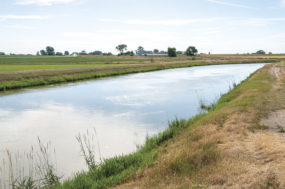Chicago: Land value declines steep
First-quarter 2016 farmland values in the Federal Reserve Bank of Chicago district (covering all or portions of Illinois, Indiana, Iowa, Michigan and Wisconsin ) were down 4 percent compared to a year earlier. Adjusted for inflation, annual declines were the steepest since 1987. Nearly two-thirds of survey respondents expected farmland values to decrease during the second quarter of 2016.
Cash rental rates experienced a 10-percent year-to-year decline, eclipsing the drop seen in 2014-2015 and representing the steepest annual decline since 1987. After adjusting for inflation, cash rental rates are now 13 percent below their 1981 level.
Agricultural credit conditions deteriorated during the quarter, with repayment rates for non-real-estate farm loans much weaker. Loan renewals and extensions were much higher.
More than one-fourth of survey respondents required more collateral to qualify for loans; none indicated smaller collateral amounts.
Survey respondents anticipated higher volumes for operating, dairy and Farm Service Agency-guaranteed loans during the second quarter of 2016. In contrast, they expected lower volumes for grain storage, farm machinery and feeder cattle loans.
Kansas City: Debt load carrying over
Poor cash flow and lower farm income are resulting in more carryover debt and loan restructuring in the Federal Reserve Bank of Kansas district, which covers all or portions of Colorado, Kansas, Missouri, Nebraska, New Mexico, Oklahoma and Wyoming.
With loan demand rising, bankers required more farm real estate as collateral for large, non-real estate farm loans.
Bankers also reported a significant increase in the use of USDA Farm Service Agency loan guarantees.
St. Louis: Similar story
Farm income erosion is reducing farm household expenditures and capital spending, as well as putting downward pressure on farmland values and cash rents in the Federal Reserve Bank of St. Louis. The district covers all or parts of Arkansas, Illinois, Indiana, Kentucky, Mississippi, Missouri and Tennessee.
Bankers said the value of quality farmland declined 6.4 percent compared to the previous year, with the quarterly decline of 2.5 percent--the steepest drop since the second quarter of 2012.
After increasing over the previous two quarters, cash rents fell.
Dallas: Land values mixed
Changes in land values within the Federal Reserve Bank of Dallas district, covering all or portions of Texas, New Mexico and Louisiana, were mixed. Districtwide, dryland values rose 1.4 percent during the quarter, and were 5.1 percent higher than a year ago. Irrigated land values decreased 5.4 percent, while ranchland values were mostly unchanged.
The December 2015 blizzard in the Texas Panhandle caused serious financial losses for many dairy and beef producers, challenging their economic viability.
Overall demand for agricultural loans decreased for a second consecutive quarter, with operating loans the only category with year-over-year increases. Loan repayment rates declined more sharply, while loan renewals and extensions picked up.
Northwest: Dairy holding back
Northwest agricultural real estate values were stable to increasing through the first quarter of 2016, according to a quarterly report from Northwest Farm Credit Services (FCS).
Agricultural property listings remain low, with many transactions occurring between landlords and tenants. The limited supply has anchored land values, despite concerns surrounding declining commodity prices and unfavorable weather patterns in select areas.
Many areas report increased investor interest in agricultural properties.
Read: Creditworthy? Ag land values pushed lower by commodity doldrums. FG

-
Dave Natzke
- Editor
- Progressive Forage Grower
- Email Dave Natzke










